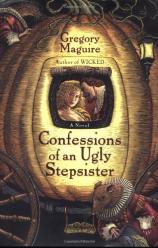Reading Group Guide
Discussion Questions
Confessions of an Ugly Stepsister

1. While versions of the Cinderella story go back at least a thousand years, most Americans are familiar with the tale of the glass slippers, the pumpkin coach, and the fairy godmother. In what ways does Confessions of an Ugly Stepsister contain the magical echo of this tale, and in what ways does it embrace the traditions of a straight historical novel?
2. Confessions is, in part, about the difficulty and the value of seeing-seeing paintings, seeing beauty, seeing the truth. Each character in Confessions has blinkers or blinders on about one thing or another. What do the characters overlook, in themselves and in one another?
3. Discuss the role of artistic representation in Confessions. Consider the two portraits the Master paints. What do they say about each other, and about art? What does the Master purport to want to capture in his paintings, and why?
4. Gregory Maguire posits four types of beauty in the novel: that of physical human grace and perfection, that of flower blossoms, that of art, and that of the gesture of charity. Is it possible to make a statement about the relative values of beauty? How is each type of beauty represented in the story?
5. Is Clara's extreme beauty really an affliction, as Iris suggests, making her just another addition to the Gallery of God's Mistakes? Do you think her beauty is a curse or a blessing?
6. Iris is possessed by visions of imps and hobgoblins -- her imagination transforms a crone into the Queen of the Hairy-Chinned Gypsies, a windmill into a ferocious giant, and smoke on the horizon into a dragon's breath. Why do you think she sees the world this way? Ultimately, is there an imp in the van den Meer house?
7. The early seventeenth century was a time in which the Dutch, it is said, invented the idea of the "comfortable home." How does the van den Meer home reflect the family within? What elements in Confessions rely on the need to keep up appearances?
8. How does the story of van den Meer's rising and falling fortunes in the tulip market relate to Clara's tale? What lessons does it offer us today?
9. Clara is preoccupied with the idea that she may be a changeling. Why does she think, even hope, that she is one? In the end, how might we redefine the term "changeling" with Clara in mind?
10. In considering Marie de Medici's scheme to marry off her godson, Margarethe professes an admiration for the Dowager Queen, saying, "Why shouldn't she arrange the world to suit herself? Wouldn't we all, if we could?" [page 243). Discuss the ways that Margarethe arranges the world to suit herself. What does her favorite saying, "Give me room to cast my eel spear, and let follow what may," tell us about her?
11. When Iris asks the crone about casting a magic spell on someone, the crone replies, "It's your own job to change yourself" (page 164). Transformation is one of the main themes of "Cinderella," and of Confessions. Discuss the ways in which the characters are transformed or transform themselves over the course of the novel. What's the value and/or the cost of transformation for each?
12. On page 65, Margarethe tells Iris, "women must collaborate or perish." Does Margarethe really believe this statement? In what ways do women collaborate or fail to collaborate in the story?
13. The novel begins and ends with the issue of charity -- Margarethe's request for charity in a strange town and Clara's act of charity toward her stepmother and stepsisters. Discuss how these scenes frame the story. At the ball, the Master says, "perhaps charity is the kind of beauty that we comprehend the best because we miss it the most" (page 313). What does this mean to you?
14. How has the book changed your conception of the Cinderella story? The notion of "happily ever after"?
Confessions of an Ugly Stepsister
- Publication Date: October 6, 1999
- Hardcover: 384 pages
- Publisher: Regan Books
- ISBN-10: 0060392827
- ISBN-13: 9780060392826








